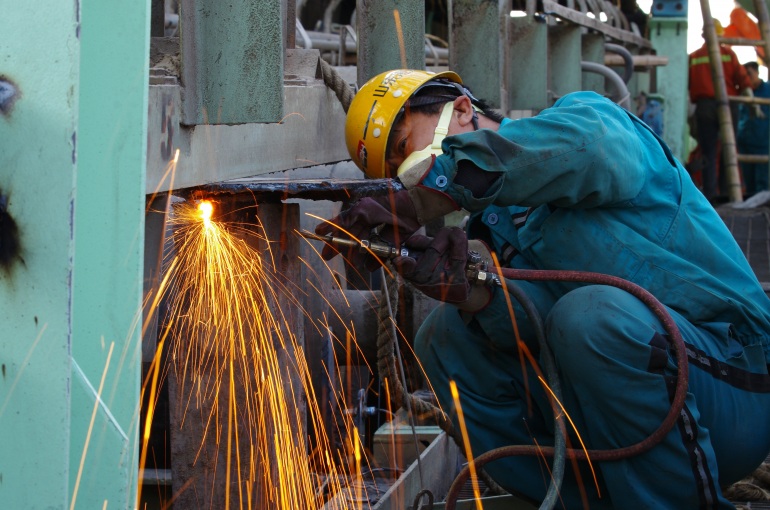Is a labour shortage looming in China?

Chinese worker welds a steel product at a factory in Rizhao city, east Chinas Shandong province. (AAPNewswire)
When we talk about China as the factory of the world, a lot of people still think most of their workers slave away on two dollars a day. That could not be further from the truth. The wages of Chinese migrant workers who form the backbone of the country’s industrial workforce have seen strong double digit growth for the past four years.
In 2013, the wages for Chinese migrant workers increased 13.9 per cent from the previous year. It was nearly twice the growth rate of China’s GDP. For the country’s 269 million migrant workers, their average wages in 2013 were 2609 Yuan, or $480 a month. Though this may not seem to be a terribly large sum of money, it is a far cry from the mystical two dollars a day.
In fact, Chinese wages increased most dramatically around the time of the global financial crisis. Between 2009 and 2013, Chinese wages surged 5.7 per cent, 19.3 per cent, 21.2 per cent, 11.8 per cent and 13.9 per cent, according to data from National Bureau of Statistics.
Why is this important? Because Chinese wages are arguably the single most important price in the world. More important than the price of a barrel of crude oil, the Federal Reserve’s interest rates or value of American dollar.
China’s total labour force is about 800 million – of which more than one third is migrant workers from rural China. It is the world’s largest labour force – almost twice that of America, the EU and Japan combined. Cheap and abundant Chinese labour is one of the key reasons why global central banks can keep interest rates low.
Low-priced manufactured goods produced by cheap Chinese labour have helped to keep inflation low. You must have noticed the steadily declining price for most electronics as well as white goods in the past decade.
However, the dramatic double digit increase in Chinese migrant workers’ wages are an ominous sign that the world’s most populous nation is about to run out of surplus labour. This proposition may seem incredulous but it is happening.
It has been widely reported that Chinese factory owners have complained about labour shortages as well as wage increases. In Guangdong, the industrial heartland of China, skilled technicians can fetch as much as 100,000 Yuan a year or $18,000.
The labour shortage pressure is borne out by the statistics. Yang Zhiming, Vice-minister of Human Resources and Social Security, told media the country’s migrant worker force increased only 2.4 per cent nation-wide last year and actually shrank 0.2 per cent in eastern coastal provinces.
The country’s one child policy, first introduced in 1979, has played an important role in causing the labour supply to slow down. The population of working age people is expected to grow at 0.7 per cent a year until 2015 and then shrink by 0.1 per cent a year until 2025.
So China is about to or has already reached the so-called “Lewis turning point”, which means the country will run out of surplus labour and wages will increase. The theory behind it was first expounded by Sir Arthur Lewis, a Nobel laureate in economics from St Lucia, who argued that a developing country with ‘surplus” or underemployed labour could expand the industrial force for years without causing wages inflation, because employers can tap into vast reserves of cheap labour in the countryside.
For years, Chinese migrant workers from the countryside have moved to the cities for jobs at factories and construction sites. Despite huge gains in productivity, the real wages of workers hardly moved during the 1980s and 1990s. The movement of workers from the countryside to cities has helped put downward pressure on manufacturing wages, not just in China but also around the world.
The dramatic increase in wages in the past four years strongly indicates that China is running out of surplus labour or has reached the Lewis turning point in its industrialisation process. Indeed, one of China’s most influential labour economists Cai Fang, who is the director of the Institute of Population and Labour Economics at the Chinese Academy of Social Sciences, argues that the country reached the point in around 2010 when migrant workers’ wages rose 19.3 per cent.
The incoming labour shortage and wages increase will have profound consequences for the world economy.
Firstly, it will force Chinese companies to put more emphasis on productivity increases through more technological upgrade and innovation or face the certain prospect of going out of business. The end of cheap labour supply will impact on one of the country’s most important comparative advantages in manufacturing – low wages.
Secondly, we are likely to see the migration of the Chinese manufacturing industry from the eastern seaboard to central and western parts of China or even or other low-cost neighbouring countries such as Vietnam.
Last but not least, the increase in real wages will help to create a new class of consumers in China. This will help to address the imbalance in the Chinese economy, which has favoured producers over consumers for the last thirty years.
China’s vast surplus labour pool is about to be exhausted. This will lead to wage increases for hundreds of millions of workers in China and the tantalising prospect of the emergence of a new consumer class – something that should get foreign investors and producers excited.
















